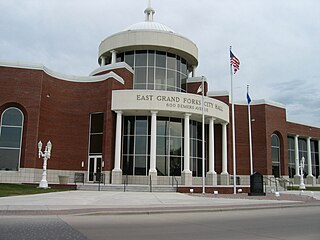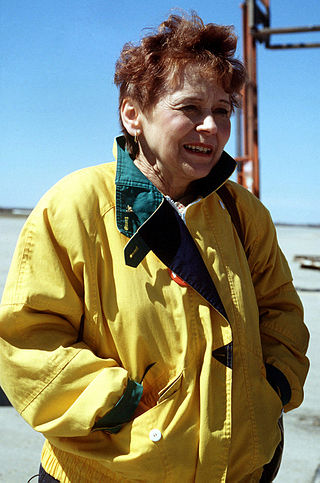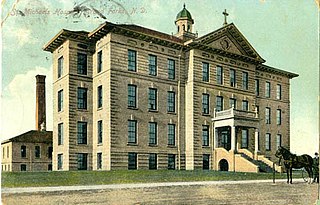This article needs additional citations for verification .(February 2022) |
The flag of Grand Forks, North Dakota was adopted on December 5, 1994.
This article needs additional citations for verification .(February 2022) |
The flag of Grand Forks, North Dakota was adopted on December 5, 1994.
The flag features green riverbanks (symbolize the life and growth of the city), blue water (symbolizes the forking of the Red River of the North and the Red Lake River at Grand Forks and the historical significance of the rivers in the development of the city), a yellow stalk of wheat (symbolizes the local importance of agriculture), a red feather (symbolizes the influence of Native Americans on the region), and a white background (symbolizes the clean air and open spaces of the area). 1870 refers to the year the name "Grand Forks" was first applied to the new community. [1]

Grand Forks County is a county in the U.S. state of North Dakota. As of the 2020 census, its population was 73,170, making it the third most populous county in North Dakota. Its county seat and largest community is Grand Forks.

Scouting in North Dakota has a long history, from the 1910s to the present day, serving thousands of youth in programs that suit the environment in which they live.

East Grand Forks is a city in Polk County, Minnesota, United States. The population was 9,176 at the 2020 Census, making it the largest community in Polk County.

Grand Forks is a city in and the county seat of Grand Forks County, North Dakota, United States. The city's population was 59,166 as of the 2020 census, making it the third-most populous city in the state, after Fargo and Bismarck. Grand Forks, along with its twin city of East Grand Forks, Minnesota, forms the center of the Grand Forks metropolitan statistical area, which is often called Greater Grand Forks or the Grand Cities.

The Red River, also called the Red River of the North to differentiate it from the Red River in the south of the continent, is a river in the north-central United States and central Canada. Originating at the confluence of the Bois de Sioux and Otter Tail rivers between the U.S. states of Minnesota and North Dakota, it flows northward through the Red River Valley, forming most of the border of Minnesota and North Dakota and continuing into Manitoba. It empties into Lake Winnipeg, whose waters join the Nelson River and ultimately flow into Hudson Bay.

The Red River flood of 1997 was a major flood that occurred in April and May 1997 along the Red River of the North in Minnesota, North Dakota, and southern Manitoba. It was the most severe flood of the river since 1826. The flood reached throughout the Red River Valley, affecting the cities of Fargo and Winnipeg, but none so greatly as Grand Forks and East Grand Forks, where floodwaters reached more than 3 miles (4.8 km) inland. They inundated virtually everything in the twin communities. Total damages for the Red River region were US$3.5 billion. The flood was the result of abundant snowfall and extreme temperatures.

"Greater Grand Forks" is the name used by some people to designate the twin cities of Grand Forks, North Dakota and East Grand Forks, Minnesota, together with their surrounding areas. The two cities lie directly across from each other on both sides of the Red River of the North, but Grand Forks, with a population of 59,166, is more than five times larger than East Grand Forks, with a population of 9,176. The metropolitan area includes all of the related two counties in the two states: Grand Forks County in North Dakota and Polk County in Minnesota. As of the 2020 census, the MSA had a population of 104,362, and in 2021 estimates placed the total population at 103,462.

Patrica A. Owens was an American politician who was the mayor of Grand Forks, North Dakota, during the flood that devastated the city in April 1997. She actively lobbied then-president Bill Clinton for funds to rebuild the city and construct a permanent flood protection system for the city and neighboring East Grand Forks, Minnesota.

The Greater Grand Forks Greenway is a huge greenway bordering the Red River and Red Lake River in the twin cities of Grand Forks, North Dakota and East Grand Forks, Minnesota. At 2,200 acres (9 km2), the Greenway is more than twice the size of New York City's Central Park. It has an extensive, 20-mile (32 km) system of bike paths, which are used by bikers, walkers, joggers, and rollerbladers. In 2007, the system was designated as a National Recreation Trail by the National Park Service.

Alexander Griggs (1838–1903) was an American steamboat captain and politician. He is acknowledged as the founder of the city of Grand Forks, North Dakota, and is called "The Father of Grand Forks." Griggs is also the namesake of Griggs County, North Dakota.
The recorded history of Grand Forks in the U.S. state of North Dakota, began with the trade between Native Americans and French fur trappers during the 19th century. About 60 buildings or other historic sites in Grand Forks survive and are recognized among the National Register of Historic Places listings in Grand Forks County.
The Grand Forks Chiefs were a minor league baseball team from Grand Forks, North Dakota. They played in the Northern League from 1934 to 1964, with a couple breaks in between.

The Sorlie Memorial Bridge, also known as the Red River Bridge, was constructed in 1929 by the Minneapolis Bridge Company to connect the cities of Grand Forks, North Dakota and East Grand Forks, Minnesota. It was placed on the National Register of Historic Places in 1999.

The Red River flood of 1997 in the United States was a major flood that occurred in April 1997, along the Red River of the North in North Dakota and Minnesota. The flood reached throughout the Red River Valley, affecting the cities of Fargo, Moorhead, and Winnipeg, while Grand Forks and East Grand Forks received the most damage, where floodwaters reached over 3 miles (5 km) inland, inundating virtually everything in the twin communities. Total damages for the Red River region were US$3.5 billion.

The building at 312 Kittson Ave, Grand Forks, North Dakota is a two-story brick commercial vernacular style building with classical details built by Swedish-American builder Sander Johnson in 1907. It is part of the Downtown Grand Forks Historic District.

St. Michael's Hospital and Nurses' Residence is a property in Grand Forks, North Dakota that was listed on the National Register of Historic Places in 1995. It was also known as St. Anne's Guest Home and denoted 32GF14, it was builtin 1907. It was designed by architect George Hancock. Grand Forks architect William J. Edwards designed the Nurses' Residence in 1913.

The Building at 201 S. 3rd St. is a property in Grand Forks, North Dakota that was listed on the National Register of Historic Places in 1982.
Viets Hotel was an 1876 vernacular Greek Revival building in Grand Forks, North Dakota. In proceeding years it had been the Richardson House, a subdivided residence, the Hall Hotel, Hotel Apartments (1940), Hall Apartments (1942–88), and Bachellor Apartments (1989–97).
The building at 205 DeMers Ave. is a property in Grand Forks, North Dakota that was listed on the National Register of Historic Places in 1982. It was destroyed by the 1997 Red River flood, and was officially delisted in 2018.

The First National Bank is a five-story building in Grand Forks, North Dakota, that was built in 1914–15 and listed on the National Register of Historic Places in 1982. It was built for the Scandinavian-American Bank, but has been identified as the First National Bank building since 1929.